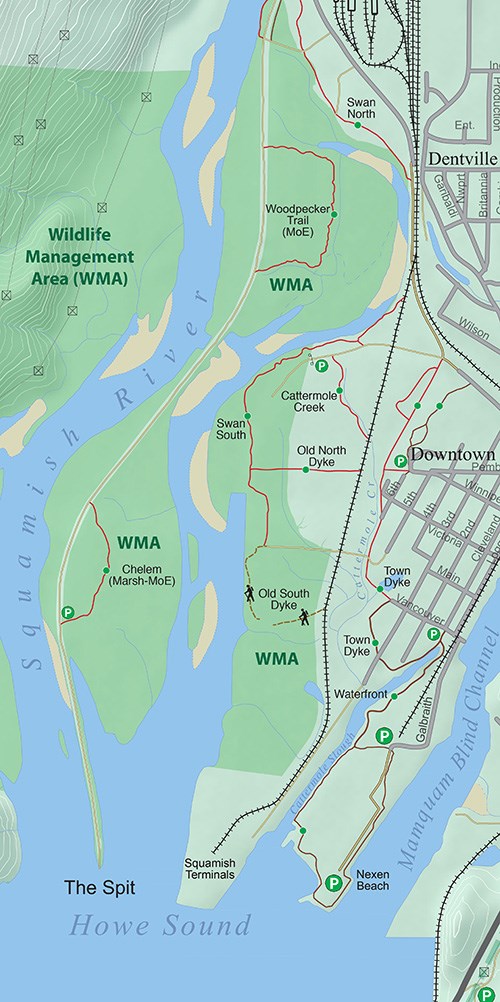There are still many tall evergreens, even Sitka spruce, among the red alders, black cottonwoods and big leaf maples along the upper reaches of Cattermole Creek in the Â鶹Éçąú˛úEstuary.
The Cattermole Slough got its name from Robert Cattermole (1924-2004), who had his logging company dredge the slough that bears his name in the 1960s. That enabled tugs to sort and form log booms in calmer waters. He was also a lead investor and strong proponent for a deep water pier which eventually became Â鶹Éçąú˛úTerminals in 1971.
Cattermole Timber Ltd. is still operating in the Chilliwack area.
This 1.2-km trail travels south along the west bank of Cattermole Creek ending at the railway line west of the Castle Rock subdivision. It is a gentle stroll under tall trees as long as you keep your eyes looking down for the many tree roots.
The creek is tidal throughout its length with the inflow/outflow being controlled by the tidal gate at Third Avenue. The railway embankment was built during the years 1965 to 1970 and constrained the flow of the Â鶹Éçąú˛úRiver and the outflow of storm water from the downtown area.
This tidal gate was put in place in 1985 to improve the flushing action within the estuary and thereby aid with local flood control. Â鶹Éçąú˛údoes need all the help it can get to reduce the impact of floods.
Cattermole Creek and trail are mostly withinĚý Site A of the Skwelwil’em Wildlife Management Area (WMA). This 30-hectare section of the protected estuary occupies the northeast corner of the WMA and was transferred to Â鶹Éçąú˛úNation ownership in 2001; with a covenant that the WMA rules would apply until the long-running treaty negotiations were completed. This co-operative management is co-ordinated by the Â鶹Éçąú˛úEstuary Management Committee (SEMC) and enforced by conservation officers of the BC Wildlife Service.
The regional manager has posted the following rules for this WMA:
*Dogs must be on leash;
*Motorized vehicles are prohibited;
*Central estuary is closed to all human activity during bird nesting season from Feb. 1 to July 1 each year; *Hiking is restricted to designated trails, meaning no incursions into protected habitat:
*Camping is prohibited;
*Bicycles are only permitted on the four designated trail.
The regional manager has the authority to ban any activities that negatively impact on wildlife and can close the WMA.
Skwelwil’em WMA covers all 673 hectares west of the railway line up to the confluence of the Mamquam and Â鶹Éçąú˛úrivers. The aim is to protect and nurture habitat for wildlife with the main emphasis on birds and fish.
The 1916 Migratory Bird Convention mandates that feeding and resting areas along flight paths be kept available. Our Important Birding Area (IBA) is BC 023 from the estuary mouth to the Cheakamus Canyon. Migrating birds should not be interfered with as they need to rest and feed for their long flights.Ěý
The second group in need of help are salmonids, a term for all salmon and trout species.
The aim is to restore and improve the safe rearing inter-tidal habitat because these young fish need the brackish waters to acclimatize before heading into the saltier ocean waters.
This is an estuary; it is an Important Birding Area. It is an Environmentally Sensitive Area (ESA); it is a WMA. It is a protected area. It is not a recreational area, and it is definitely not an off-leash area for dogs!
Ěý
Ěý
Origin of name: Robert Cattermole (1924-2004) had his logging company dredge the slough that bears his name in the 1960s.
Trailhead: near the west end of the decommissioned section of Bailey street.
Use: Hiking only, because the rules for this wildlife management area only allow bicycles on municipal trails.
Difficulty: Green despite the plethora of tree roots.
Elevation: 6 to 7 metres.
Etiquette: Dogs must be on leash in this Wildlife Management Area.
Feedback: [email protected]




